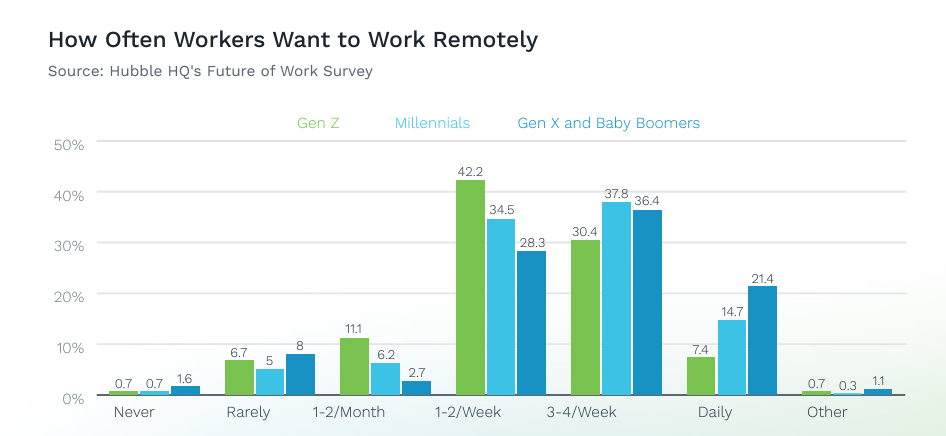In-Office, Hybrid, or Remote? Why Compromise is the Key to Success in the Workplace Debate
The pendulum swing of who has power in the current labor market — workers quitting for better (remote) jobs versus employers jettisoning those who won’t return to the office — is still in flux.
Workers: Robust Remote Job Market
According to research from our 2024 Tech Salary Guide, five of the eight job titles that have the highest percentage of fully remote workers are tech workers, and 77% of respondents of one tech talent survey said that they would be willing to work fully remotely for their job.
Additionally, workers are conflicted about a return to the office, as only 28% of workers said their company is making it worthwhile to come into the office, however over 50% of frontline workers believe that being fully in the office was ideal for career advancement.
Tech workers moving out of the cities and away from company offices during COVID were under the impression that full work from home would continue indefinitely. However, once demands for returning to the office were put into place, many of those who moved had an untenable commute. A Gallup survey found that 52% of those who prefer working remotely listed avoiding commuting time as a top reason they don’t want to go into the office.
Managers: Proximity Bias Toward In-Office
That same survey showed that 62% of senior business leaders believe there’s a proximity bias between the in-person and remote/hybrid workforce. In other words, the tendency of leadership to show favoritism or preferential treatment to employees that are close to them physically.
Nevertheless, there continues to be a tech talent shortage across the United States, with nearly four million tech jobs available across the industry. With unemployment at historic lows and talent shortages widespread, many employers have been grudgingly accommodating employees’ desire for remote and hybrid work.
For one thing, it is costly to replace unhappy employees. According to SHRM, it costs about one-third of an employee’s salary to replace them, according to industry norms, and that’s only if HR and hiring managers can find a qualified candidate who is willing to accept the position.
Something Has to Give
When it comes to 2024, flexibility will be the key to a thriving work environment. Both job seekers and companies will need to be able to compromise, and that compromise seems to have landed on a hybrid schedule with expanded local hiring.
While most workers feel that five days in the office is a non-starter for a job and will not accept an offer if it is full-time in the office, many tech workers are becoming more accepting of the hybrid schedule.
Interestingly, there is a noticeable difference between generations in their preferences of where they are working, with Gen Z mostly looking to be in the office multiple times a week, while Generation X and Baby Boomers are the age group most likely to want to work from home full time.

According to discussions with leaders on the Motion Recruitment team, fewer companies and hiring managers want to do a nationwide search for most roles and are willing to shrink the possible candidate pool to get candidates that are local to their office.
Multiple recruiters mentioned that even if a role a company is hiring for can be done fully remotely, many are employing a 50 or 100-mile “bubble.” This hiring strategy allows for a worker to do their job completely from home but is available to head into the office as needed for major meetings and workshopping without major expenses such as flights and hotels.
Read More: 7 Tips for Developers and Tech Leaders for Success in a Remote or Hybrid Office
Companies and managers can keep workers happy while being in the office by making sure that there is an added benefit to being there. Nothing feels worse than to be the only one working in a ghost town. And tech workers forced into sparsely populated offices only to sit at a desk with headphones on will see no benefit of being in the office.
When getting into the office leads to things like one-on-one time with managers to go over career goals and promotional paths, collaborations with team members that are difficult to do over Teams calls or hands-on upskilling opportunities, then employees tend to look at heading to the office more favorably.
Compromise, Compromise, Compromise
For both sides, the crux of the issue is continuing the conversation and making sure value is being added. For those looking to work from home full-time, productivity has to be maintained.
Numerous studies have attempted to measure if those who work from home are more or less productive than those in the office, there hasn't been any true consensus, and it does come down to the individual.
Stuck in the middle of all this — facing both up and down the organizational chart — are managers, who must mediate between leaders and individual contributors. Success will come down to knowing how an employee will work best along with having a manager that knows how to get the best out of a worker, no matter where they are doing their job.
According to Forbes, there are so many different ways organizations can successfully approach a hybrid or remote model – it’s not a one-size-fits-all approach.
“A remote work policy doesn’t mean you won’t meet people. It just requires fostering connections in different ways, and it certainly means that companies need to get creative and invest resources in making that happen.”
Getting Creative
A couple of suggestions:
- Flexible Scheduling: Employers can offer flexible work hours, allowing employees to choose their working hours within a certain framework. This can accommodate different time zones and personal responsibilities.
- Core Hours: Establishing core hours when all employees are expected to be available can facilitate collaboration while still offering flexibility. For instance, having a set period during the day when everyone is online can be effective for team meetings and synchronous work.
- Rotational In-Office Days: In a hybrid model, employers can set specific days for in-office attendance. This can be on a rotational basis to ensure that the office is not overcrowded, and employees get to have face-to-face interactions with different team members over time
- Clear Communication Channels: Maintaining open and regular communication channels is essential. Regular check-ins, virtual team-building activities, and clear documentation can help in bridging the gap between remote and in-office teams.
- Performance-Based Evaluation: Shifting the focus from hours worked to performance and output can be a more effective way of evaluating employees, fostering a culture of trust and accountability.
- Regular Feedback and Surveys: Regularly soliciting feedback from employees about their work arrangement preferences and challenges can help employers make informed decisions and adjustments.
- Hybrid Meetings: For team meetings, having a hybrid setup where both in-office and remote team members can participate equally can foster inclusivity.
- Trial Periods: Implementing trial periods for different work arrangements can give both employers and employees a chance to evaluate what works best before making a long-term commitment.
- Professional Development Opportunities: Ensuring that remote and hybrid employees have the same access to professional development and career advancement opportunities as in-office employees.
Ultimately, the future of hybrid work will not be determined by organizational policy but by organizational culture – and culture is the ever-evolving outcome of relationships among people throughout the business. Cultivating and caring for those relationships is the most important thing you can do to ensure an effective hybrid work strategy.



